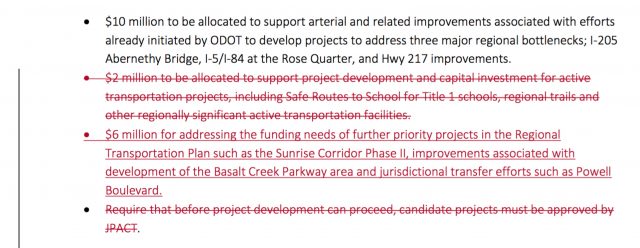(Photos: J. Maus/BikePortland)
A nearly two-year quest to raise funds for Safe Routes to Schools across the Portland region came to an end this morning. At the monthly meeting of Metro’s Joint Policy Advisory Committee on Transportation, elected and agency leaders voted to support a policy direction that will inform how $130 million in federal “flexible” transportation dollars are spent.
“If we are truly committed to solving freight bottlenecks and if we are truly committed to air quality we’d be discussing investments that will improve traffic flow.”
— Paul Savas, Clackamas County Commissioner
Back in August 2014 the Bicycle Transportation Alliance zeroed in on this pot of money as a way to bring Safe Routes funding to all 150,000 of the region’s schoolkids. They built up the For Every Kid coalition with 89 partners and campaigned for $15 million to be dedicated to a mix of programmatic (education and marketing) and infrastructure spending around schools. This morning the coalition filled two sides of the Metro Council Chambers with people holding bright yellow signs that read, “Invest in Safe Routes” and “Don’t Cut Biking and Walking.”
As we reported back in March the proposal up for adoption had nowhere near the $15 million the coalition had hoped for. Instead that number was $1.5 million — or just $500,000 per year for the three-year funding cycle. With that battle fought, and the final vote postponed last month until today, the only remaining suspense was whether or not any JPACT member would try to amend the proposal in a significant way.
And boy did one of them try.
The proposal on the table called for bonding $3.78 million out of the flexible fund pot to create $12 million in revenue for freight and active transportation project development: $10 million for “regional bottlenecks” at the I-205 Abernethy Bridge, I-5/I-84 at the Rose Quarter, and Hwy 217; and $2 million for, “capital investment for active transportation projects, including Safe Routes to School for Title 1 schools, regional trails and other regionally significant active transportation facilities.”
Then came Clackamas County Commissioner Paul Savas.
Savas put forward an amendment that would have completely eliminated the $2 million for active transportation projects and he proposed an additional $6 million in project development funds for major highway projects (he named Sunrise Corridor and the Basalt Creek Parkway specifically).
Commissioner Savas said we need more and wider highways because car and truck congestion is causing 30% more toxic fumes to be spewed into the air. “If we are truly committed to solving freight bottlenecks and if we are truly committed to air quality we’d be discussing investments that will improve traffic flow,” he said.
Once put to the committee for discussion, Savas’ amendment was quickly denounced.
Metro Councilor Sam Chase was not thrilled:
“I would really speak out and say that this is not the right approach… We are often looking at one strategy to address freight issues in our region and I think we’re missing the bigger picture… By taking out active transportation, by taking out those components that take cars off the road, we’re fighting against our own economic development strategy. If you talk to business leaders they talk about quality of life and active transportation is part of that. I think it’s short-sighted… I think we need to protect the active transportation investments for the future of our region.”
Savas also wanted to reduce high capacity transit bond commitments by $5 million. TriMet General Manager Neil McFarlane said those cuts would be, “Fundamentally nearly fatal to our capacity to advance these projects.”
And then came the final nail in the coffin: Wilsonville Mayor Tim Knapp — representing the cities of Clackamas County — said that even he could not support Savas’ amendment.
When the vote on his amendment was called, Savas was the only JPACT member to vote “yes” on his amendment. It failed 15-1. And that wasn’t the only lonely vote for Savas. He was also the only person to vote against the policy package that was ultimately adopted.
When the dust settled, Safe Routes to School didn’t do anywhere near as well as advocates had hoped — but there are some positives.
In addition to the $500,000 per year in Safe Routes program funding, there’s the $2 million in project development and capital investment that will will be split up between capital investments in Safe Routes projects near Title 1 schools, regional multi-use paths, and other active transportation projects. And on the infrastructure side, the adopted proposal includes $26 million for active transportation projects. Another small step for Safe Routes is that improving access to schools has been upgraded to the highest priority in project selection criteria.
This $130 million in spending will be spread out across three years, 2019-2021. The next step is for agencies and jurisdictions to come up with project proposals. Those lists are due to Metro by August and will be out for public comment in October. A final funding decision will be made in January 2017.
— Jonathan Maus, (503) 706-8804 – jonathan@bikeportland.org
Our work is supported by subscribers. Please become one today.
The post Highway amendment fails, Metro committee adopts spending plan appeared first on BikePortland.org.
from Front Page – BikePortland.org http://ift.tt/27FNf0e


No comments:
Post a Comment